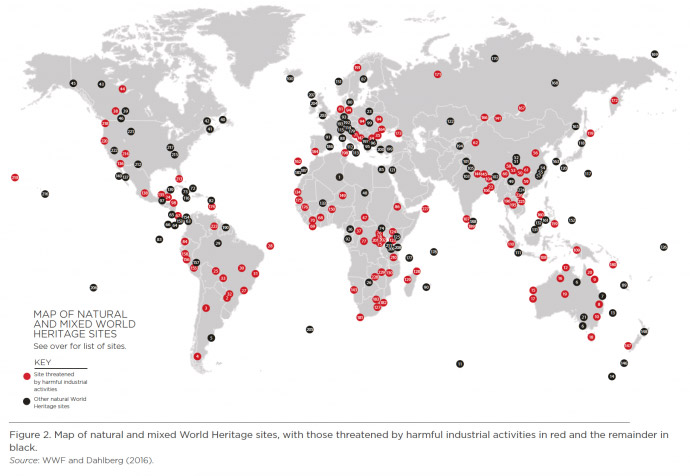WWF-SIGHT results used in UNESCO World Heritage report
UNESCO’s new report ‘World Heritage for Sustainable Development in Africa‘ has been released this March, including spatial analysis and maps derived from WWF-SIGHT.
The chapter of the report ‘Sustainable development at natural World Heritage sites in Africa’ (pages 51-61) includes contributing writers from the Zoological Society of London (ZSL), Wildlife Conservation Society (WCS) and World Wide Fund for Nature (WWF), and recognises the role of conservation NGOs as a key source of support for natural World Heritage Sites.
Threats to natural World Heritage sites from extractives and other harmful industrial activities are particularly high and increasing in Africa, and in many cases contributing to the listing of sites as ‘in danger’.
Recent combined analysis for WWF by Dalberg Global Development Advisors is referenced in the report, which found that half (114) of 229 natural and mixed World Heritage sites are threatened by harmful industrial activities based on WWF-SIGHT analysis and IUCN data.

WWF-SIGHT results are also referenced in the UNESCO report: “Spatial analysis conducted by the WWF in 2015 found that 70 out of 229, or 31%, of natural World Heritage sites were overlapped by extractives activities or concessions” as published in our ‘Safeguarding outstanding natural value’ report.
“In Africa, this proportion rose to 61%. This analysis used the most comprehensive industry datasets on mining activities available, but these are costly, not publicly available and can be restricted in what they contain and what can be released, resulting in incomplete results.”

With growing private sector ‘no-go’ and ‘no-impact’ commitments regarding harmful infrastructure activities, the report states that a clear vision is required between the private sector as well as governments, NGOs and communities.

Read the full report here (PDF): World Heritage for Sustainable Development in Africa [external link]